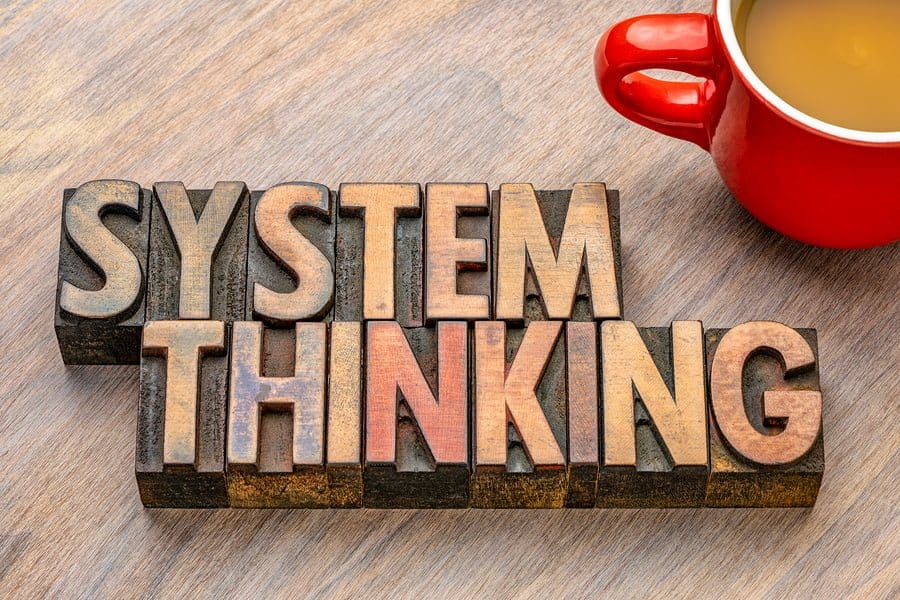One of the biggest breakthroughs in understanding the complexities of an organization can be found in the field of systems thinking. All organizations strive to be as efficient, productive, and profitable as possible. However, in attempting to be so, one of the biggest challenges leaders face is successfully orchestrating the many different divisions, teams and technologies in order that they work together effectively as a whole with one overarching vision and purpose. Systems thinking is about looking at the complete picture, about analyzing the relationships between the different parts of a system to unlock the potential for better decision-making.
Table of Contents
ToggleWhat Is a System?
Perhaps you’ve heard of systems thinking. Perhaps you’re already doing it, or perhaps you’ve heard that you should be doing it. But what is systems thinking – and, more importantly, what does it mean for the senior manager?
Well, first, we need to break down what me mean by “system”. In simple terms, a system is any kind of entity that is made up of parts that interact. These parts and their interactions create a whole, which, when working together, produces some kind of result. Naturally, changing one part of a system has consequences for other parts in the system, which in turn affects the whole system. Essentially, in a functioning system, everything is reliant upon something else in order for that system to remain functioning.
Systems have purpose. All parts within a system are not independent, but interdependent in some way. Without interdependencies, all we have is a collection of parts or things. Let’s think about this with a straightforward example. Your car is a system. It is a system because it has a purpose – to transport you and whomever else you’re travelling with from A to B. This purpose, however, is a property of the system as a whole, and not of any of your car’s individual parts – wheels, engine, steering wheel, dashboard, etc. – as they do not embody the system’s purpose individually, only when working together.
In order for a system to perform its purpose at an optimal level, all parts must be present. If you’re driving down the road and all of a sudden get a flat tire, you’re not going anywhere until you replace it – even if your engine is still running smoothly.
What Is Systems Thinking in Business?
Many leaders rely on linear thinking to solve business problems. This type of thinking is cause-and-effect thinking, but only in the most basic of terms – one cause has one effect. Sometimes, linear thinking can be adequate to solve a problem. Returning to the analogy with your car once more – if you run out of gas (cause), your car will splutter to halt (effect). This type of problem is easily enough solved with linear thinking – put some more gas in the tank.
But of course, organizations are made up of many, many complex relationships and interdependencies that affect each other, often in unexpected ways. Systems thinking in business is about looking at the complete picture – about looking at the dynamics of a system to understand what forces are pushing individual parts in one way or another.
Systems thinking is useful in a wide range of scenarios – for instance, in determining whether something is a problem or merely a symptom of something deeper. Linear thinking tends to focus on addressing surface-level symptoms. Too often, however, making a surface-level symptom go away doesn’t solve the underlying problem. For example, if a company has a domineering culture, employees can often feel victimized or scapegoated by management. But when feeling victimized, a lot of employees will start to complain about other things – they’re overworked, say, or they have personal problems – rather than reveal their true feelings. In such scenarios, though a number of symptoms may be present, the true problem remains hidden. With linear thinking, HR may find ways to address symptoms individually, but the underlying problem will still be there. With systems thinking, on the other hand, leaders work to understand the root causes of underlying problems before they start addressing any symptoms. Usually, if the true problem is identified and solved, all symptoms are eliminated as well.
Systems thinking is also useful when it comes to decision making and resource planning. With a systems thinking approach, all business decisions are analyzed based on the systematic consequences they will have. For example, if a company decides to invest in a new computer software program, systems thinking requires that a thorough analysis first be conducted of the additional infrastructure that may be needed (now and in the future), as well as any employee hiring and training costs, and any delays or dips in productivity that may result while staff get to grips with it.
Another example would be the relationship between aggressive marketing campaigns and the pressures (and burdens) they place on other departments that can limit company growth. Let’s say an IoT manufacturer has produced a new sensor that monitors the state of repair of air conditioning units in homes and office buildings. The growing action of marketing promotions, however, soon hits a wall in the face of the limited capacity of field technicians to install the sensors as well as call center personnel to handle customer service concerns. Systems thinking will not only unearth the root causes of the unmanageable growth problem, but also lead the company to making better strategic choices in balancing its focus between the growing action (marketing promotions) and the limiting factors (capacity of field technicians and service representatives). In addition, finger-pointing between marketing and operations as to who is at fault for hindering growth can be diminished, and better collaboration between all departments achieved.
Final Thoughts
Systems thinking helps leaders to understand why certain aspects of the business – including its people – behave as they do. It is a methodology that can be used as both a diagnostic and prescribing tool to help solve persistent business problems. It involves examining problems much more thoroughly and accurately before acting, enabling leaders to ask better questions before jumping to conclusions. Through observing events or data from a wider perspective, systems thinking allows the organization to identify patterns and behavior, and surface the underlying structures and relationships that are driving them.
In our next post, we’ll take a deeper dive into systems theory, and explore some of the tools used as well as how to use them.
Summary:
An Introduction to Systems Thinking
A system is any kind of entity that is made up of parts that interact. These parts and their interactions create a whole, which, when working together, produces some kind of result. Naturally, changing one part of a system has consequences for other parts in the system, which in turn affects the whole system. Essentially, in a functioning system, everything is reliant upon something else in order for that system to remain functioning. Many leaders rely on linear thinking to solve business problems. This type of thinking is cause-and-effect thinking, but only in the most basic of terms – one cause has one effect. Sometimes, linear thinking can be adequate to solve a problem. But of course, organizations are made up of many, many complex relationships and interdependencies that affect each other, often in unexpected ways. Systems thinking in business is about looking at the complete picture – about looking at the dynamics of a system to understand what forces are pushing individual parts in one way or another.Systems thinking is useful in a wide range of scenarios – for instance, in determining whether something is a problem or merely a symptom of something deeper. Systems thinking is also useful when it comes to decision making and resource planning. Systems thinking helps leaders to understand why certain aspects of the business – including its people – behave as they do. It is a methodology that can be used as both a diagnostic and prescribing tool to help solve persistent business problems.”






